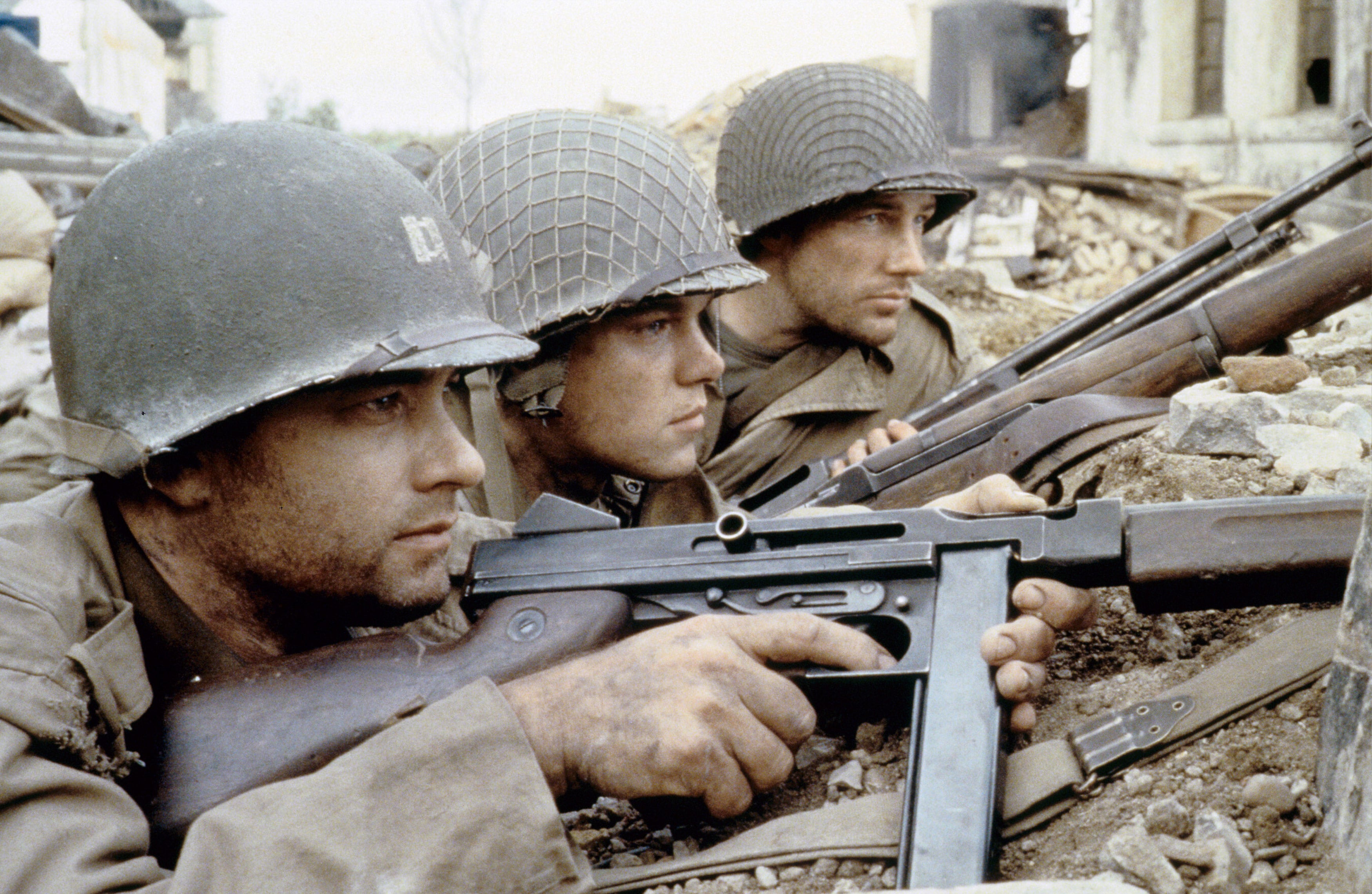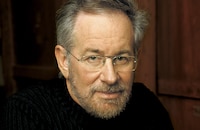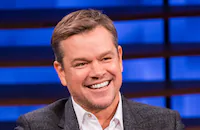Saving Private Ryan

Brief Synopsis
Cast & Crew
Steven Spielberg
Tom Hanks
Matt Damon
Ed Burns
Adam Goldberg
Vin Diesel
Film Details
Technical Specs
Synopsis
James Ryan, who has parachuted into France during the Allied invasion of Europe, has just lost three brothers in combat. Government policy dictates that he should return home lest his family be deprived of all its male offspring. A team of soldiers, led by Captain John Miller and fresh from the beaches of Normandy, is assembled to find and save Private Ryan.
Director

Steven Spielberg
Cast

Tom Hanks

Matt Damon
Ed Burns
Adam Goldberg
Vin Diesel

Tom Sizemore
Giovanni Ribisi
Jeremy Davies
Nick Brooks
Michelle Evans
John Barnett
Martin Mcdougall
Paschal Friel
Rob Freeman
Maclean Burke
Sam Ellis
Paul Hickey
Shane Mikael Johnson
Ryan Hurst
Eric Loren
Grahame Wood
Max Martini
Nathan Fillion
Nigel Whitmey
Leland Orser
Barry Pepper
Victor Burke
Stephan Cornicard
Raph Taylor
Markus Napier
Shane Hagan
Matthew Sharp
Harve Presnell
Dennis Farina
Andrew Scott
Gerald Perreau
Erich Redman
Ian Porter
Glenn Wrage
Tilo Keiner
Dorothy Grumbar
Loclann Aiken
Thomas Rolfs
Aiden Condron
Bryan Cranston
Marc Cass
Brian Maynard
Julian Spencer
Thomas Gizbert
Steve Griffin
Gary Sefton

Paul Giamatti
Paul Garcia
Tim Morrison
Crofton Hardester
Harrison Young
Valerie Colgan
Anna Maguire
David Vegh
David Wohl
Dale Dye
Danny Cerqueria
James Innes-smith
Rolf Saxon
Dylan Bruno
John Sharian
John Walters
Neil Finnighan
Corey Johnson
Ted Danson
Stephan Grothgar
Adam Shaw
Michael Mantas
Sam Scudder
Mark Phillips
Lee Rosen
Laird Macintosh
Joerg Stadler
Demetri Goritsas

Kathleen Byron
William Marsh
Amanda Boxer
Vincent Walsh
Ronald Longridge
Martin Beaton
Seamus Mcquade
Martin Hub
Crew
Sharon Aiken
Colin Anderson
Terry Apsey
Alan Armsby
Lori Arnold
Carl Assmus
Derek Atherton
Simon Atherton
Trang Bach
Norman Baker
Garret Baldwin
Michael Barlett
Rupert Barnes
John Barnett
Christopher Barrick
Ciaran Barry
Bradley Barton
Colin Bates
Bryan Baverstock
Clive Beard
Kathleen Beeler
Fiona Belton
Andy Bennett
Dan Bennett
Gary Birmingham
Anthony Black
Peter Black
Cath Blackett
Marek Bojsza
Sara Bolder
Alan Booth
Steve Borthwick
Caimin Bourne
Clodagh Bowers
Nigel Boyd
Joanna Branch
Stuart Bray
Stephen Bream
Christopher Brennan
Robert Brian
David Brighton
Dan Britton
Kim Bromley
Stephen Brown
Tom Brown
Ian Bryce
Alex Burdett
Jane Burgess
Simon Burgess
Gary Burritt
Elaine Burt
Lois Burwell
Maeve Butler
Richard Byard
Chris Byrne
Pavel Cajzl
Marc Cass
Steve Caswell
Paul Catling
Viktor Cervenka
Denise Chamian
Lisa Chino
Freddie Chiverton
Terry Chostner
Philip Clark
Stuart Clarke
Tania Clarke
Jeff Clifford
James Cloney
Simon Cockren
Matt Codd
John Coleman
Matt Colleran
Aron Collins
Aris Comninos
Stuart Conran
Caitlin Content
Henri Contet
Hillery Cope
Cliff Corbould
Ian Corbould
Neil Corbould
Paul Corbould
Seamus Corcoran
Robert Cowper
Terry Cox
Simon Cozens
Lee Craik
Laurie Crane
Patrick Crane
Simon Crane
David Crossman
Allan B Croucher
Mike Cuevas
Chris Cullum
Daisy Cummins
Mike Curran
Aileen Curtin
Bonnie Curtis
Frank Darabont
Sophie Dasic
Kathleen Davidson
Robin Davies
Stephen Dawson
Sandy De Crescent
Kevin De La Noy
Eddie De Lange
Ray De-haan
Lisa Dean
David Deane
Cian Debutlear
Michael Deegan
Gerry Delaney
Berny Demolski
Maria Devane
Patrick Devereux
David Devlin
Lindy Diamond
Stuart Digby
Paul Dimmer
Rob Doherty
Noel Donellon
Daniel T. Dorrance
Jim Dowhall
Dean Drabin
William Draper
Lisa Drayne
Mitch Dubin
Catherine Dunne
Tommy Dunne
Mike Durkan
Dale Dye
Polly Earnshaw
Tony Eckert
Teresa Eckton
Peter Edmonds
Cos Egan
Duke Ellington
Rosalyn Ellis
Dan Engstrom
Gonzalo Escudero
Frank Eulner
David Evans
John Evans
Ricky Eyres
Sheila Fahey
Sven E M Fahlgren
Stefen Fangmeier
Mike Faulkner
Martha Fein
Andre Fenley
Raymond Ferguson
Carlos Fidel
Neil Finnighan
Ann-marie Fitzgerald
Tim Flattery
John Flemming
Veronique Fletcher
Robert Foley
Johnny Fontana
Dave Forster
John Fox
Andrew France
Sarah J Francis
Scott Frank
Scott Frank
Erica Frauman
Gary Freeman
Jeanette Freeman
Joanne Frye
Marc Fusco
Katie Gabriel
George Gambetta
Alex Garcia
Andy Garder
Barry Gates
John Gear
Joseph Geday
Tim Geideman
Colin Gibbs
Donal Gilligan
Alex Gladstone
Lavinia Glynn-jones
Philip Goldsworthy
Jennifer Gonzalez
Adam Goodman
Bridget Goodman
Mark R. Gordon
Melanie Gore Grimes
Neill Gorton
Barrie Gower
Nina Graham
Dale Grahn
Siobhan Grant
Jonathan Greber
Steve Griffin
Sian Grigg
Kenny Groom
Alan Grosch
Darren Grosch
Videos
Movie Clip




Trailer
Film Details
Technical Specs
Award Wins
Best Cinematography
Best Cinematography
Best Director
Best Director
Best Editing
Best Film Editing
Best Sound
Best Sound
Best Sound
Best Sound
Best Sound
Best Sound Effects Sound Editing
Best Sound Effects Sound Editing
Best Sound Effects Sound Editing
Award Nominations
Best Actor
Set Decoration
Best Makeup
Best Original Screenplay
Best Picture
Best Score (Dramatic Picture)
Articles
Saving Private Ryan
"I've had an obsession with World War II," confessed Spielberg in an interview conducted during the production of the film. His father fought in the Burma campaign in World War II as a radio man in a fighter plane. As a young teen, Spielberg and his friends created World War II adventures on super 8 film. He'd previously touched on the war in such films as 1941 (a homefront comedy, 1979), Empire of the Sun (a child's-eye view of survival in an internment camp, 1987) and his acclaimed Holocaust drama Schindler's List [1993], but Saving Private Ryan was his first classical war film, a platoon drama about the experience of American soldiers in combat.
The script was inspired by a true story: the Niland family had lost three of their four sons to the war. The War Department, still remembering the five Sullivan brothers who all died while serving on the same battleship (which led to the policy of preventing siblings from serving together), was not going to let it happen again. They sent a platoon to pull the fourth Niland son out of harm's way; he was a young soldier who had parachuted in with the 101st on D-Day. Robert Rodat's script fictionalizes the particulars but draws upon real history to tell the story of the soldiers who land on Omaha Beach on June 6, 1944. The real-life landing was a slaughter. The pre-invasion barrage had failed to knock out the dug-in German guns and heavily-entrenched soldiers on the hills above the beach and the Germans slaughtered the first wave of American soldiers.
Spielberg transformed the scene into the film's most visceral and memorable accomplishment: the shell-shock of the brutal, bloody, in-your-face chaos of American soldiers hitting the beach on D-Day. The unrelenting barrage of exploding shells and pelting gunfire on a beach littered with the bodies and limbs of American soldiers hits the audience like an assault on the senses. "I tried to be as brutally honest as I could with what I had," explained Spielberg. Bullets tear through air, water, flesh; men stagger about, lost and limbless; explosions shatter the dull scream of war; soldiers bleed, fall, and die, just so many bodies in the detritus of battle. Spielberg's razor-sharp images are charged with panic and his camera is almost too alert as it takes in the shocking information overload. War has never been portrayed as so intimidating, so terrifying, so arbitrarily destructive. It may be the closest Hollywood has ever come to recreating the combat experience, thanks in large part to Spielberg's brilliant orchestration of the chaos. The experience sent some veterans reeling into vivid flashbacks and stunning audiences into an awed, aghast, and humble silence.
Tom Hanks is quietly authoritative as Captain John Miller, whose platoon Ð Sgt. Horvath (Tom Sizemore), Privates Reiben (Edward Burns), Jackson (Barry Pepper), Mellish (Adam Goldberg), Caparzo (Vin Diesel) and Medic Wade (Giovanni Ribisi) Ð survives the harrowing landing and is given a new, unconventional mission: to head behind enemy lines to find and retrieve Private James Ryan (Matt Damon).
Hanks was a longtime friend of Spielberg but they had never worked together on a film before. Coming upon the same script independently, they discussed the possibilities and decided to collaborate. The collaboration was so successful, and the subject matter so compelling, that Spielberg and Hanks reteamed to produce the mini-series Band of Brothers (based on the book by Stephen Ambrose) for HBO. For the young soldiers in the platoon, Spielberg (who has always had a knack for discovering young talent) went looking for unfamiliar faces to inhabit characters that were at once familiar war movie types and individual personalities. Good Will Hunting [1997] had yet to elevate Matt Damon's star when he was cast as Ryan, a small but essential role in the film. Adam Goldberg was best known for his role in Dazed and Confused [1993], Giovanni Ribisi was a TV veteran who had played a small role in Tom Hanks' directorial debut That Thing You Do! [1996], Jeremy Davies was a talented actor in a few American Indie productions (Spanking the Monkey, 1994), and Barry Pepper and Vin Diesel were virtual unknowns when Spielberg cast them. You'll also see Paul Giamatti in a small role as an officer; the exposure gave his struggling career a major boost. To prepare his actors for their roles, Spielberg turned to war veteran turned war movie consultant Dale Dye, who acted as drill sergeant for a six-day boot camp and crash course in physical training, weapons training and military culture.
The Omaha Beach invasion was staged on the coast of Ireland. Vintage landing crafts were brought in from all over the world. Hundreds of members of the Irish Army were hired as extras and hundreds of guns were loaded with blanks for the actors and extras on the front lines of the film (the rest were issued rubber guns). The actors wore earplugs to protect them from the noise of the explosives and ordnance used to create the spectacle of the German assault on the landing. Computer effects were used to add background explosions and fill out long shots with more soldiers and chaos. For the film's other major location, a French village set, the company built their own village in a rural field in Hatfield, just North of London. They actually constructed real, functional buildings and then destroyed them to create an authentically war-scarred look.
Spielberg reteamed with Janusz Kaminski, his regular cinematographer since Schindler's List. "Very early on in the process, we both knew that we did not want this to look like a Technicolor extravaganza about World War II. We wanted it to look very much like color newsreel footage from the 1940s, which is highly desaturated and very grainy and extremely low tech." The camerawork was all handheld in the combat scenes, to evoke a quality of combat newsreel footage as well as the jittery immediacy of the action. Kaminski had special lenses made to defuse the image slightly and sent the negative to a lab to further leech the color out. "There's virtually not a single shot that shows a blue sky." The skip-frame effects, created in post-production, added a stuttery visual quality and added to the sense of adrenaline-charged immediacy.
Saving Private Ryan was one of Spielberg's most acclaimed films. "This film simply looks at war as if war had not been looked at before," wrote New York Times critic Janet Maslin, who described the film as "the ultimate devastating letter home." Roger Ebert declared: "Saving Private Ryan says things about war that are as complex and difficult as any essayist could possibly express, and does it with broad, strong images, with violence, with profanity, with action, with camaraderie." It earned five Academy Awards, including Spielberg's second Oscar® for Best Director and Janusz Kaminski's second award for Best Cinematography. It was nominated for eleven awards in all, including Best Picture, Best Screenplay and Best Actor (Tom Hanks) and remains one of the most celebrated films about the American soldier experience in World War II.
Producers: Ian Bryce, Mark Gordon, Gary Levinsohn, Steven Spielberg
Director: Steven Spielberg
Screenplay: Robert Rodat
Cinematography: Janusz Kaminski
Art Direction: Daniel T. Dorrance (supervising art director); Tom Brown, Ricky Eyres, Chris Seagers, Alan Tomkins; Mark Tanner (uncredited)
Music: John Williams
Film Editing: Michael Kahn
Cast: Tom Hanks (Capt. John H. Miller), Tom Sizemore (Sgt. Mike Horvath), Edward Burns (Pvt. Richard Reiben), Barry Pepper (Pvt. Daniel Jackson), Adam Goldberg (Pvt. Stanley Mellish), Vin Diesel (Pvt. Adrian Caparzo), Giovanni Ribisi (T-4 Medic Irwin Wade), Jeremy Davies (Cpl. Timothy P. Upham), Matt Damon (Pvt. James Francis Ryan), Ted Danson (Capt. Fred Hamill), Paul Giamatti (Sgt. Hill), Dennis Farina (Lt. Col. Anderson).
C-170m. Letterboxed.
by Sean Axmaker

Saving Private Ryan
Quotes
Trivia
Miscellaneous Notes
Winner of the 1999 Golden Laurel Award for Best Motion Picture from the Producers Guild of America.
Nominated for the 1998 award for Best Screenplay Written Directly for the Screen (Robert Rodat) from the Writers Guild of America.
Steven Spielberg was nominated for Outstanding Directorial Achievement in 1998 by the Directors Guild of America.
Winner of five 1998 awards, including for Best Film, Best Ensemble, Best Director, Best Cinematography and Best Editing from the Online Film Critics Society.
Winner of the 1998 award for Best Cinematography from the Boston Society of Film Critcs.
Winner of the 1998 award for Best Film from the New York Film Critics Circle.
Winner of the 1998 award for Best Picture from the Chicago Critics Film Association. Nominated for a further three awards, including Best Director, Best Cinematography and Best Actor (Tom Hanks).
Winner of the 1998 Eddie Award for Best Edited Feature Film (Michael Kahn) from the American Cinema Editors.
Winner of the 1998 Golden Satellite Award for Outstanding Film Editing (Michael Kohn) from the International Press Academy.
Winner of three 1998 awards, including Best Picture, Best Director, and Best Cinematography from the Los Angeles Film Critics Association.
Winner of two 1998 Broadcast Film Critics Association awards, including Best Director (Steven Spielberg) and Best Score (John Williams). Nominated for the award for Best Picture.
Released in United States Summer July 24, 1998
Re-released in United States February 5, 1999
Released in United States on Video May 25, 1999
Released in United States 1998
Released in United States September 1998
Shown at Venice Film Festival (out of competition) August 26 - September 8, 1998.
Shown at Deauville Festival of American Film September 4-13, 1998.
Mutual Film co was previously known as Cloud Nine Entertainment.
Began shooting June 27, 1997.
Completed shooting September 13, 1997.
Steven Spielberg and Tom Hanks reportedly took no money upfront but agreed to split 35% of gross receipts, which brought them as much as $50 million each.
Re-released in France March 17, 1999.
Released in United States Summer July 24, 1998
Re-released in United States February 5, 1999
Released in United States on Video May 25, 1999
Released in United States 1998 (Shown at Venice Film Festival (out of competition) August 26 - September 8, 1998.)
Released in United States 1998 (Film had its French premiere at the 1998 Deauville Festival of American Film.)
Released in United States September 1998 (Shown at Deauville Festival of American Film September 4-13, 1998.)
Winner of the 1999 Artios Award for Feature Film - Drama by the Casting Society of America (CSA).














